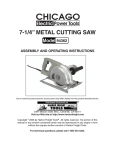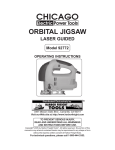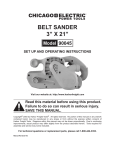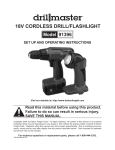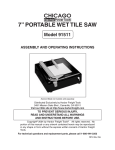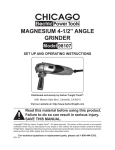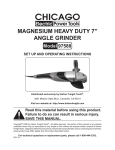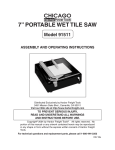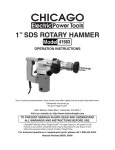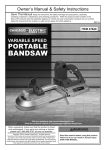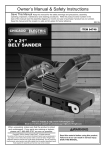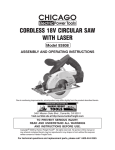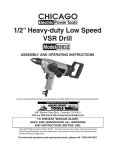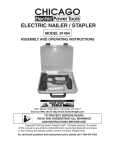Download Harbor Freight Tools 45804 User's Manual
Transcript
10” BENCH TABLE SAW - 2 HP Model 45804 ASSEMBLY AND OPERATING INFORMATION ® 3491 Mission Oaks Blvd., Camarillo, CA 93011 Visit our Web site at http://www.harborfreight.com To prevent serious injury, Read and understand all warnings and instructions before use. Copyright© 2004 by Harbor Freight Tools®. All rights reserved. No portion of this manual or any artwork contained herein may be reproduced in any shape or form without the express written consent of Harbor Freight Tools. For technical questions please call 1-800-444-3353. PRODUCT SPECIFICATIONS ITEM DESCRIPTION Electrical Requirements 2 HP Motor /12 Volt /60 Hz 13 Amps /3,600 RPM Blade Size Capacity 10” Diameter / 5/8” Arbor (blade not included) Overall Dimensions 22-3/4” W x 26” L x 15-1/2” H Table Dimensions 26” W x 17-1/2” L Adjustable Rip Fence Size 17-3/4” W x 1-7/8” L Scale Measurement Increments Inches / Metric Maximum Rip With Fence 9-1/2” Blade Adjustments 90 Degrees to 45 Degrees Cutting Capacity 2-7/8” at 90 Degrees 2-5/16” at 45 Degrees Weight 32.85 Lbs. Accessories Included: Fence Assembly, Blade Guard, Bottom Plate, Mitre Guide, Push Stick, Elevation Wheel Handle, 3 Hex Wrenches (4mm, 5mm, 6mm), 2 Spanner Wrenches * NOTE: Recommended Blade (not included): Item #529 - 10” M2 Molybdenum Tipped (40 Tooth) saw blade. E194601 SAVE THIS MANUAL You will need this manual for the safety warnings and precautions, assembly, operating, inspection, maintenance and cleaning procedures, parts list and assembly diagram. Keep your invoice with this manual. Write the invoice number on the inside of the front cover. Keep this manual and invoice in a safe and dry place for future reference. GENERAL SAFETY RULES WARNING! READ AND UNDERSTAND ALL INSTRUCTIONS Failure to follow all instructions listed below may result in electric shock, fire, and/or serious injury. SAVE THESE INSTRUCTIONS WORK AREA 1. Keep your work area clean and well lit. Cluttered benches and dark areas invite accidents. SKU 45804 PAGE REV 07j 2. Do not operate power tools in explosive atmospheres, such as in the presence of flammable liquids, gases, or dust. Power tools create sparks which may ignite the dust or fumes. 3. Keep bystanders, children, and visitors away while operating a power tool. Distractions can cause you to lose control. Protect others in the work area from debris such as chips and sparks. Provide barriers or shields as needed. ELECTRICAL SAFETY 4. Grounded tools must be plugged into an outlet properly installed and grounded in accordance with all codes and ordinances. Never remove the grounding prong or modify the plug in any way. Do not use any adapter plugs. Check with a qualified electrician if you are in doubt as to whether the outlet is properly grounded. If the tools should electrically malfunction or break down, grounding provides a low resistance path to carry electricity away from the user. 5. Double insulated tools are equipped with a polarized plug (one blade is wider than the other). This plug will fit in a polarized outlet only one way. If the plug does not fit fully in the outlet, reverse the plug. If it still does not fit, contact a qualified electrician to install a polarized outlet. Do not change the plug in any way. Double insulation eliminates the need for the three wire grounded power cord and grounded power supply system. 6. Avoid body contact with grounded surfaces such as pipes, radiators, ranges, and refrigerators. There is an increased risk of electric shock if your body is grounded. 7. Do not expose power tools to rain or wet conditions. Water entering a power tool will increase the risk of electric shock. 8. Do not abuse the Power Cord. Never use the Power Cord to carry the tools or pull the Plug from an outlet. Keep the Power Cord away from heat, oil, sharp edges, or moving parts. Replace damaged Power Cords immediately. Damaged Power Cords increase the risk of electric shock. 9. When operating a power tool outside, use an outdoor extension cord marked “W-A” or “W”. These extension cords are rated for outdoor use, and reduce the risk of electric shock. PERSONAL SAFETY 10. Stay alert. Watch what you are doing, and use common sense when operating a power tool. Do not use a power tool while tired or under the influence of drugs, alcohol, or medication. A moment of inattention while operating power tools may result in serious personal injury. SKU 45804 PAGE 11. Dress properly. Do not wear loose clothing or jewelry. Contain long hair. Keep your hair, clothing, and gloves away from moving parts. Loose clothes, jewelry, or long hair can be caught in moving parts. 12. Avoid accidental starting. Be sure the Power Switch is off before plugging in. Carrying power tools with your finger on the Power Switch, or plugging in power tools with the Power Switch on, invites accidents. Make sure you are prepared to begin work before turning the Power Switch (179) “ON”. 13. Remove adjusting keys or wrenches before turning the power tool on. A wrench or a key that is left attached to a rotating part of the power tool may result in personal injury. 14. Do not overreach. Keep proper footing and balance at all times. Proper footing and balance enables better control of the power tool in unexpected situations. 15. Always wear eye, hearing, and breathing protection. Wear ANSI approved safety impact eye glasses, ANSI approved hearing protectors, and ANSI approved dust mask or respirator when using this product. Also, non-skid safety shoes and a hard hat must be used for appropriate conditions. TOOL USE AND CARE 16. Use clamps (not included) or other practical ways to secure and support the workpiece to a stable platform. Holding the work by hand or against your body is unstable and may lead to loss of control. 17. Do not force the tool. Use the correct tool for your application. The correct tool will do the job better and safer at the rate for which it is designed. There are certain applications for which this saw was designed. Do not use this saw to do the work of a larger saw. Do not use this product for a purpose for which it was not intended. Do not force the material into the Saw Blade when cutting. Apply moderate pressure, allowing the Saw Blade to cut without being forced. 18. Do not use power tool if the Power Switch does not turn it on or off. Any tool that cannot be controlled with the Power Switch is dangerous and must be replaced. 19. Disconnect the Power Cord Plug from the power source before making any adjustments, changing accessories, or storing the tool. Such preventive safety measures reduce the risk of starting the tool accidentally. 20. Store idle tools out of reach of children and other untrained persons. Tools are dangerous in the hands of untrained users. 21. Maintain tools with care. Keep cutting tools sharp and clean. Properly maintained tools with a sharp cutting edge are less likely to bind and are easier to control. Do not use a damaged tool. Tag damaged tools “Do not use” until repaired. SKU 45804 PAGE 22. Check for misalignment or binding of moving parts, breakage of parts, and any other condition that may affect the tool’s operation. If damaged, have the tool serviced before using. Many accidents are caused by poorly maintained tools. 23. Use only accessories that are recommended by the manufacturer for your model. Accessories that may be suitable for one tool may become hazardous when used on another tool. SERVICE 24. Tool service must be performed only by qualified repair personnel. Service or maintenance performed by unqualified personnel could result in a risk of injury. 25. When servicing a tool, use only identical replacement parts. Follow instructions in the “Inspection, Maintenance, And Cleaning” section of this manual. Use of unauthorized parts or failure to follow maintenance instructions may create a risk of electric shock or injury. GROUNDING WARNING! Improperly connecting the grounding wire can result in the risk of electric shock. Check with a qualified electrician if you are in doubt as to whether the outlet is properly grounded. Do not modify the power cord plug provided with the tool. Never remove the grounding prong from the plug. Do not use the tool if the power cord or plug is damaged. If damaged, have it repaired by a service facility before use. If the plug will not fit the outlet, have a proper outlet installed by a qualified electrician. GROUNDED TOOLS: TOOLS WITH THREE PRONG PLUGS 1. Tools marked with “Grounding Required” have a three wire cord and three prong grounding plug. The plug must be connected to a properly grounded outlet. If the tool should electrically malfunction or break down, grounding provides a low resistance path to carry electricity away from the user, reducing the risk of electric shock. (See Figure A, next page.) 2. The grounding prong in the plug is connected through the green wire inside the cord to the grounding system in the tool. The green wire in the cord must be the only wire connected to the tool’s grounding system and must never be attached to an electrically “live” terminal. (See Figure A.) SKU 45804 PAGE 3. Your tool must be plugged into an appropriate outlet, properly installed and grounded in accordance with all codes and ordinances. The plug and outlet should look like those in the following illustration. (See Figure A.) FIGURE A DOUBLE INSULATED TOOLS: TOOLS WITH TWO PRONG PLUGS 4. Tools marked “Double Insulated” do not require grounding. They have a special double insulation system which satisfies OSHA requirements and complies with the applicable standards of Underwriters Laboratories, Inc., the Canadian Standard Association, and the National Electrical Code. (See Figure B.) 5. Double insulated tools may be used in either of the 120 volt outlets shown in the following illustration. (See Figure B.) FIGURE B SKU 45804 PAGE EXTENSION CORDS 1. Grounded tools require a three wire extension cord. Double Insulated tools can use either a two or three wire extension cord. 2. As the distance from the supply outlet increases, you must use a heavier gauge extension cord. Using extension cords with inadequately sized wire causes a serious drop in voltage, resulting in loss of power and possible tool damage. (See Figure C) 3. The smaller the gauge number of the wire, the greater the capacity of the cord. For example, a 14 gauge cord can carry a higher current than a 16 gauge cord. (See Figure C, and Figure D.) 4. 5. If using more than one extension cord to make up the total length, make sure each cord contains at least the minimum wire size required. 6. If you are using an extension cord outdoors, make sure it is marked with the suffix “W-A” (“W” in Canada) to indicate it is acceptable for outdoor use. 7. Make sure your extension cord is properly wired and in good electrical condition. Always replace a damaged extension cord or have it repaired by a qualified electrician before using it. 8. Protect your extension cords from sharp objects, excessive heat, and damp or wet areas. If you are using one extension cord for more than one tool, add the nameplate amperes and use the sum to determine the required minimum cord size. (See Figure C, and Figure D.) FIGURE C SKU 45804 PAGE SYMBOLOGY Double Insulated Canadian Standards Association Underwriters Laboratories, Inc. V~ A no xxxx/min. Volts Alternating Current Amperes No Load Revolutions per Minute (RPM) SPECIFIC SAFETY RULES 1. Maintain labels and nameplates on the Saw. These carry important information. If unreadable or missing, contact Harbor Freight Tools for a replacement. 2. Industrial applications must follow OSHA requirements. 3. Check for damaged parts. Before using this product, carefully check that it will operate properly and perform its intended function. Check for damaged parts and any other conditions that may affect the operation of this product. Replace or repair damaged or worn parts immediately. 4. Do not use this tool for cutting metals or brittle materials. Do not cut dangerous materials, such as asbestos which can cause harmful dust or vapors. 5. Allow the Saw Blade to spin up to full speed before feeding wood into it. When turning it off, allow the Saw Blade to spin down and stop on its own. Do not press against the Saw Blade to stop it. 6. Never pass hands directly over the Saw Blade when cutting the workpiece. Push the workpiece into the Saw Blade, using the Push Stick (37). 7. Never attempt to remove material stuck in the moving parts of the Table Saw while it is plugged in and running. 8. Turn off the Table Saw if the woodstock is to be backed out of an uncompleted cut. 9. Always feed the woodstock into the Saw Blade and against its rotation. 10. Make sure the woodstock is supported at all times while sawing. Use a Roller Stand (not provided) with larger woodstocks if necessary. SKU 45804 PAGE 11. Before trying new or complicated techniques, study the procedure, and practice with scrap wood. 12. Make sure the woodstock is free from loose knots, flaws, nails, and from any other foreign objects that could damage the Saw Blade or cause “kickback”. 13. Causes and operator prevention of “kickback”: Kickback is a sudden reaction to a pinched, bound, or misaligned Saw Blade, causing an uncontrolled woodstock to lift up and out of the Table Saw toward the operator. When the Saw Blade is pinched or bound tightly by the kerf closing down, the Saw Blade stalls and the motor reaction drives the tool rapidly back toward the operator. If the Saw Blade becomes twisted or misaligned in the cut, the teeth at the back edge of the Saw Blade can raise the workpiece (walk-up), and eject it towards the operator. Kickback is a result of tool misuse and/or incorrect operating procedures or conditions and can be avoided by taking proper precautions as given below: • Maintain control of the woodstock at all times. Never allow the woodstock to rest on the moving Saw Blade without holding on to it. • When the Saw Blade is binding, or when interrupting a cut for any reason, turn off the Power Switch and hold the woodstock motionless on the Table Saw until the Saw Blade comes to a complete stop. Never attempt to remove the woodstock from the Table Saw or pull the woodstock backward while the Saw Blade is in motion or kickback may occur. Investigate and take corrective actions to eliminate the cause of Saw Blade binding. • When restarting a woodstock on the Table Saw, center the Saw Blade in the pre-cut kerf and check that the saw teeth are not engaged into the woodstock. If the Saw Blade is binding, the woodstock may walk up or kickback from the workpiece as the Table Saw is restarted. • Support large panels to minimize the risk of Saw Blade pinching and kickback. Large panels tend to sag under their own weight. Supports must be placed under the panel and near the outer edge of the panel. • Do not use a dull or damaged Saw Blade. Unsharpened or improperly set Saw Blades produce a narrow kerf causing excessive friction, Saw Blade binding and kickback. • Never use the Fence Assembly (75) as a guide when crosscutting. • Never rip a woodstock that is twisted or warped, or does not have a straight edge to guide along the Rip Fence. • Push the wood stock past the Saw Blade prior to release. 14. Check all guards for proper operation before each use. Never disable any guards. Do not operate the Table Saw if the Guard Assembly does not move freely and close instantly. Before each use, raise the Guard Assembly and make sure it moves freely and does not touch the Saw Blade or any other part, in all angles and depths of cut. SKU 45804 PAGE 15. Always use the proper size and type of Saw Blade (3): Item #529 is recommended - 10” M2 Molybdenum Tipped (40 Tooth) saw. 16. Never perform layout, assembly, or setup work on the Table of the Table Saw when the machine is running. 17. Always disconnect the Table Saw from its electrical outlet before performing any services, maintenance, or cleaning such as leaving the work area, moving the tool from one location to another, changing Saw Blades, cleaning sawdust from the unit, etcetera. 18. Before use, the Table Saw should be placed on a flat, stable surface, capable of supporting the weight of the tool and workpiece, and any additional pressure caused by working on it. Mounting the Table Saw to the surface is recommended -see Appendix A on page 22 for mounting details. 19. WARNING! Some dust created by power sanding, sawing, grinding, drilling, and other construction activities, contain chemicals known (to the State of California) to cause cancer, birth defects or other reproductive harm. Some examples of these chemicals are: (a) Lead from lead-based paints; (b) Crystalline silica from bricks and cement or other masonry products; (c) Arsenic and chromium from chemically treated lumber. Your risk from these exposures varies, depending on how often you do this type of work. To reduce your exposure to these chemicals; work in a well ventilated area, and work with approved safety equipment, such as those dust masks that are specially designed to filter out microscopic particles. (California Health & Safety Code 25249.5, et seq.) 20. WARNING! People with pacemakers should consult their physician(s) before using this product. Electromagnetic fields in close proximity to a heart pacemaker could cause interference to or failure of the pacemaker. UNPACKING When unpacking, check to make sure all parts shown on the Parts Lists and Assembly Diagrams on pages 18-21 are included. If any parts are missing or broken, please call Harbor Freight Tools at the number shown on the cover of this manual as soon as possible. Note: While unpacking and before attempting assembly; loosen the motor, remove the two styrofoam inserts that hold the motor in place during packing, and retighten the motor. SKU 45804 PAGE 10 ASSEMBLY INSTRUCTIONS NOTE: For additional references to the parts listed in the following pages, refer to the Assembly Diagrams on pages 20 and 21 of this manual. To Attach The Bottom Plate: 1. Turn the saw Base (188) over, and position the Bottom Plate (193) in place. (See Figure D.) 2. Line up the four holes. Secure Bottom Plate in place using the 4 cross head screws (be careful not to overtighten) that are packed in the small plastic bag included in the box. Figure D To Install A Saw Blade: 1. WARNING! Prior to installing a Saw Blade (3), make sure the Table Saw is disconnected from its electrical power source. To help prevent injury, heavy work gloves are recommended when replacing the blade. 2. Unscrew the two Screws (96) located on the Cover (101), and remove the Cover to expose the Saw Blade opening. (See Figure E.) HEX BOLT (1) FLAT WASHER (2) WASHER “A” (3) FENCE ASSY. (75) SCREW (96) COVER (101) (REMOVED) SCREW (96) FIGURE E SAW BLADE (3) (not included) SKU 45804 SHAFT (#7) PAGE 11 Warning! Be very careful during blade tightening and loosening to avoid contact with the blade. 3. Carefully reach into the Saw Blade opening and remove the Hex Nut (1) and Blade Pad (2) from the Shaft (6) avoiding contact with the blade. 4. Insert the Saw Blade (3) at a slight angle (10°) and place the Blade on the Shaft (6). FENCE ASSY. (75) NOTE: Make sure the teeth of the Saw Blade (not included) are pointing toward the FRONT of the SAW BLADE (3) Table Saw. Follow the (not included) directional arrow shown on the Saw Blade when mounting the Blade. REAR OF FRONT OF See Figure F. FIGURE F TABLE SAW TABLE SAW 5. Place the Blade Pad (2) onto the Shaft (6). Next, hand tighten the Hex Nut (1) onto the Shaft. 6. In order to keep the Saw Blade (3) from turning during this step, use the Open-end Spanner (39) to hold the Blade Pad (2). Then while holding the Open-end Spanner firmly in place, wrench tighten the Hex Nut (1) with the Spanner (38) onto the Shaft (6) to secure the Saw Blade. Position your hand well away from the blade teeth to avoid injury if your hand was to slip while tightening. 7. Once the Saw Blade (3) is secured onto the Shaft (6), replace the Cover (101) and the two Screws (96). See Figure E, previous page. To Attach The Guard Assembly: 1. WARNING! Prior to installing the Guard Assembly (50), make sure the Table Saw is disconnected from its electrical power source. 2. Put the Guard Assembly in place over the table. The Guard Assembly attaches to the mounting post shown in Figure G. Simply slip the Guard Assembly over the mounting post. Place a Spring Washer (62), Washer (64), and Big Washer (61) over the Socket Head Screw (63) and thread into the end of the mounting post. Use the included 4 mm Hex Wrench (196) to tighten the Socket Head Screw (63). See Figure H. SKU 45804 PAGE 12 Mounting Post Figure G Figure H 3. As shown in Figure I, now tighten the 4 Socket Head Screws (65) to secure the guard bracket in place. 4. To adjust the height of the Blade Guard Assembly (50), FIGURE I loosen the Hex Screws (68). Raise the Guard Assembly to the desired height. Then retighten the two Hex Screws. See Figure J. After making any adjustments to or installing the Blade Guard Assembly (50), make sure that the Guard is aligned properly and doesn’t contact the Blade. To Attach The Fence Assembly: Figure J 5. 1. CAUTION! Prior to installing the Fence Assembly (75), make sure the Table Saw is disconnected from its electrical power source. 2. To attach Fence Assembly (75) to the Table (105), raise the Fence Handle (80) to a horizontal position. Slip the Front Board (94) of the fence over the front edge of the Table. (See Figure K) 3. Slip the rear Clamp (89) of the Fence Assembly onto the top/rear edge of the Table, lowering the Fence Assembly all the way onto the Table (105). Then, lock the Fence Assembly in position by lowering the Fence Handle to a vertical position. (See Figure L) BLADE GUARD ASSY. (50) Tension Adjustment Screw Figure K FENCE ASSY. (75) Fence Handle (80) (UNLOCKED POSITION) FIGURE L SKU 45804 PAGE 13 SAW BLADE (3) (not included) RULER SUPPORT (86) BLADE GUARD ASSY. (50) FENCE ASSY. (75) GRADUATION SCALE LOCKING KNOB (167) Fence Handle (80) (LOCKED POSITION) ANGLE INDICATOR ANGLE SCALE SWITCH (179) CIRCUIT BREAKER (178) WHEEL (170) FIGURE M OPERATING INSTRUCTIONS To Raise And Lower The Saw Blade: 1. When cutting, the top edge of the Saw Blade (3) should rise about 1/4” above the top edge of the workpiece. 2. To raise the height of the Saw Blade (3), unlock the Locking Knob (167) by turning it counterclockwise. Next, turn the Wheel (170) clockwise until the desired height is acquired. Then, turn the Locking Knob clockwise to lock the Saw Blade in position. (See Figure M.) 3. To lower the height of the Saw Blade (3), unlock the Locking Knob (167) by turning it counterclockwise. Next, turn the Wheel (170) counterclockwise until the desired height is acquired. Then, turn the Locking Knob clockwise to lock the Saw Blade in position. (See Figure M.) To Adjust The Angle Of The Saw Blade: 1. The Table Saw is capable of making cuts from 90 degrees to 45 degrees. 2. The Table Saw also features an Angle Scale and Angle Indicator on the front side of the unit. (See Figure M.) SKU 45804 PAGE 14 3. To adjust the angle of the Saw Blade (3), unlock the Locking Knob (167) by turning it counterclockwise. Push the Wheel inward to engage the gear, then turn it until the red pointer indicates the desired angle. Then, turn the Locking Knob clockwise to lock the Saw Blade in position. (See Figure M, previous page.) Note that the socket head screws in the table top (Figure N) are used to adjust the 0 degree and 45 degree positive stops. Figure N To Adjust The Width Of A Cut: 1. The width of a cut is achieved by moving the Fence Assembly (75) to the right or left. (See Figure M.) 0 Degree 45 Degree 2. The Table Saw features a Graduation Scale on the front of the unit. The Scale’s measurements are in both inches and metric increments. (See Figure M.) 3. To position the Fence Assembly (75) for the desired width of a cut, unlock the Fence Handle (80) by raising it upward. (See Figure M.) 4. Place the workpiece on the Table Saw against the Fence Assembly (75). Next, slide the workpiece, and the Fence Assembly, to the right or left until the left side of the Ruler Support (86) indicates on the Graduation Scale the desired width to be cut. Then, lock the Fence Assembly in place by lowering the Fence Handle (80). (See Figure M.) Proper Placement Of Hands During The Cutting Process: Warning: Review all warnings, especially the Specific Safety Rules found on page 8, before performing any cutting procedure. 1. WARNING! Always keep all guards in place and in working order. 2. Use the Push Stick (37) or an Auxiliary Handle (not included) only when ripping widths of 2” to 6”. Use a Push Block (not included) when ripping widths under 2”. Refer to Appendix B on page 22 for instructions on how to make and use a Push Block. 3. When ripping, always use the Fence Assembly (75). This improves the accuracy of the cut, and reduces the chance for Saw Blade binding. 4. Never pass hands directly over the Saw Blade (3) when cutting the workpiece. Always push the workpiece into the Saw Blade, using the Push Stick (37). (See Figure O, next page.) 5. At the start of the cut, the left hand holds the workpiece firmly on the Table (105) and against the Fence Assembly (75), The right hand, with the aid of the Push Stick (37), pushes the workpiece toward the turning Saw Blade (3). (See Figure O.) 6. After the cut is under way the right hand, with the aid of the Push Stick (37), continues pushing the workpiece forward. Just before the cut is near completion SKU 45804 PAGE 15 move the left hand safely away from the workpiece and the Saw Blade (3). Then, continue pushing the workpiece into the Saw Blade, with the Push Stick, until the cut is complete. (See Figure O.) 7. Once the cut is complete, continue to maintain control of the workpiece. Turn the Power Switch (179) to its OFF position. Then, wait until the Saw Blade (3) completely stops rotating before removing the workpiece. NOTE: TOP VIEW OF TABLE BLADE GUARD ASSY. (50) SAW BLADE (3) FENCE ASSY. (75) WORKPIECE CUT LINE PUSH Stick (37) FIGURE O TABLE SAW OVERLOAD PROTECTION 1. The Table Saw is equipped with a Circuit Breaker (178). If the motor shuts off or fails to start due to overloading (cutting stock too fast, using a dull Saw Blade (3), low voltage, using the Table Saw beyond its capacity, etc.), turn the Power Switch (179) to its OFF position. Let the motor cool three to five minutes, and push the Circuit Breaker button which will reset the overload device. The motor can then be turned on again in the usual manner. (See Figure P.) Figure P INSPECTION, MAINTENANCE, AND CLEANING 1. 2. WARNING! Always disconnect the Table Saw from its electrical power supply source before performing any inspection, maintenance, or cleaning procedure. Before each use, inspect the general condition of the Table Saw. Inspect switch, power plug and cord assembly, and extension cord (if used) for damage. Check for loose screws, misalignment, binding of moving parts, broken, cracked, or improper mounting of the Saw Blade (3), broken parts and any other condition that may affect its safe operation. If abnormal noise or vibration occurs, turn off the Table Saw immediately and have the problem corrected before further use. Do not use damaged equipment. SKU 45804 PAGE 16 3. Remove cut-off pieces and scraps from the Table before starting the Table Saw. Before cutting, ensure the machine is switched off. While the Saw Blade (3) is completely stopped; unplug the machine, remove the Blade following the instructions on pages 11 and 12, and remove all debris. Warning! Allowing sawdust, scraps, or other debris to accumulate can cause a fire, resulting in severe personal injury or property damage. 4. With a brush, soft cloth, or vacuum, remove all sawdust from the Table Saw. 5. Do not use solvents to wipe off the Table Saw, as damage may result. If necessary, wipe with a damp cloth. You may use a mild detergent. Warning! Do not introduce water into the electric motor through the motor vents. 6. Once clean, lubricate all moving parts with a light oil. 7. When storing, keep the Table Saw covered with a cloth cover. PLEASE READ THE FOLLOWING CAREFULLY THE MANUFACTURER AND/OR DISTRIBUTOR HAS PROVIDED THE PARTS DIAGRAM IN THIS MANUAL AS A REFERENCE TOOL ONLY. NEITHER THE MANUFACTURER NOR DISTRIBUTOR MAKES ANY REPRESENTATION OR WARRANTY OF ANY KIND TO THE BUYER THAT HE OR SHE IS QUALIFIED TO MAKE ANY REPAIRS TO THE PRODUCT OR THAT HE OR SHE IS QUALIFIED TO REPLACE ANY PARTS OF THE PRODUCT. IN FACT, THE MANUFACTURER AND/OR DISTRIBUTOR EXPRESSLY STATES THAT ALL REPAIRS AND PARTS REPLACEMENTS SHOULD BE UNDERTAKEN BY CERTIFIED AND LICENSED TECHNICIANS AND NOT BY THE BUYER. THE BUYER ASSUMES ALL RISK AND LIABILITY ARISING OUT OF HIS OR HER REPAIRS TO THE ORIGINAL PRODUCT OR REPLACEMENT PARTS THERETO, OR ARISING OUT OF HIS OR HER INSTALLATION OF REPLACEMENT PARTS THERETO. SKU 45804 PAGE 17 PARTS LIST A (Parts 1-95) NO. 1 2 3 4 5 6 7 8 9 10 11 12 13 14 15 16 17 18 19 20 21 22 23 24 25 26 27 28 29 30 31 32 33 34 35 36 37 38 39 40 41 42 43 44 45 46 47 48 PART NAME Hex Nut Blade Pad Saw Blade (not included) Blade Press Circle Press Washer Shaft Screw Spring Washer Board Cover Ball Bearing Bearing Stand Round Key Big Gear Pin Bearing Gear Box Ball Bearing Armature Separate Circle Ball Bearing Stator-Assy Plane Washer Spring Washer Screw Wind Washer Cabinet Carbon Brush Handle Carbon Brush Connection Seating Rubber Set Rear Cover Power Cord Wire Clip Screw Screw Spring Washer Plane Washer Push Stick Spanner Open-end Spanner Assembly of Miter Guide Lock Angle Ruler Body Round Pin Plane Washer Angle Ruler Body Screw Spring Washer Angle Ruler Finger QTY 1 1 1 1 1 1 3 3 1 1 1 1 1 1 1 1 1 1 1 1 2 2 2 1 1 2 2 1 1 1 1 1 2 3 3 3 1 1 1 1 1 1 1 1 1 1 1 1 SKU 45804 NO. 49 50 51 52 53 54 55 56 57 58 59 60 61 62 63 64 65 66 67 68 69 70 71 72 73 74 75 76 77 78 79 80 81 82 83 84 85 86 87 88 89 90 91 92 93 94 95 PAGE 18 PART NAME Angle Ruler Bolt Blade Guard Assembly Cover Rod Lock Pin Spring Washer Blade Guard Double Direction Spring Stop Card Hex Nut Big Washer Non Metal Lock Screw Set Pad Big Washer Spring Washer Socket Head Screw Plane Washer Socket Head Screw Support Board Washer Hex Screw Big Washer Hex Bolt Hex Bolt Spring Pin Blading Board Washer Fence Assembly Stress Bolt Ruler Body Hex Bolt Washer Fence Handle Hex Nut Long Nut Bias Wheel Pin A Pin B Ruler Support Spring Board Press Spring Clamp Pad Ruler Screw Lock Washer Front Board Spring Pin QTY 1 1 1 2 2 1 1 2 1 2 1 1 1 1 1 1 4 1 2 2 2 1 1 1 1 2 1 1 1 2 2 1 1 1 1 1 1 1 1 1 1 1 1 1 1 1 1 REV 04j PARTS LIST B (Parts 96-196) NO. 96 97 98 99 100 101 102 103 104 105 106 107 108 109 110 111 112 113 114 115 116 117 118 119 120 121 122 123 124 125 126 127 128 129 130 131 132 133 134 135 136 137 138 139 140 141 142 143 144 145 146 PART NAME Screw Washer Screw Board Lock Nut Cover Hex Bolt Square Bolt Hex Bolt Working Table Graduation Scale Rivet Bottom Base A Bottom Base B Hex Bolt Plane Washer Spring Pin Holding Board D Spacer Lock Nut Holding Board C Holding Board A Shape Tube Lock Nut Lock Washer Hex Bolt Lock Nut Pin Shaft Movable Nut Rod Wheel Shaft Spring Pin Inner-Hex Bolt Spring Washer Defence Board Strap Clamp Connect Board Washer Nut Hex Bolt Plane Washer Hex Bolt Hex Screw Screw Lock Washer Angle Indicator Assembling Lock Nut Holding B Pin Ferrule Lock Nut Spring Pin QTY 2 2 2 1 2 1 1 6 1 1 1 3 2 12 3 3 1 1 1 1 1 1 2 2 4 3 1 1 1 1 1 1 1 1 1 1 1 2 1 2 1 1 1 1 1 3 1 1 1 2 1 SKU 45804 NO. 147 148 149 150 151 152 153 154 155 156 157 158 159 160 161 162 163 164 165 166 167 168 169 170 171 172 173 174 175 176 177 178 179 180 181 182 183 184 185 186 187 188 189 190 191 192 193 194 195 196 PAGE 19 PART NAME Hex Nut Spring Washer Inner-Hex Bolt Plane Washer Spring Washer Lock Nut Axis Hex Nut Spring Pin Axis Lock Washer Hex Bolt Warning Label Label Half Round Bolt Washer A Hex Nut Big Washer Spacer Board Big Washer Locking Knob Screw Board Hand Wheel Hex Nut Wheel Handle Screw Using Mark Press Spring Nut Protect Label Circuit Breaker Power Switch Screw Switch Board Screw Cable Protect Washer Cord Support Inner Cable Rubber Feet Base Corer Screw Lock Washer Hex Bolt Mounting Plate Hex Wrench 5mm Hex Wrench 6mm Hex Wrench 4mm QTY 3 3 1 3 1 6 1 2 1 1 2 1 1 1 1 1 1 1 1 1 1 9 1 1 1 1 1 1 1 1 1 1 1 4 1 2 1 1 1 1 4 1 1 2 5 5 1 1 1 1 Assembly Diagram A (Parts 1-95) SKU 45804 PAGE 20 Assembly Diagram B (Parts 96-192) Note: Part 193-Mounting Plate- not shown. Part 194,195, and 196-Hex Wrenches- not shown. NOTE: Some parts are listed and shown for illustration purposes only, and are not available individually as replacement parts. SKU 45804 PAGE 21 Appendix A Mounting Instructions Warning: Mounting the saw should only be done with the power cord unplugged and the sawblade removed. If mounting onto a stand: 1. Make sure the stand is designed to handle the weight of this machine, plus any additional weight placed on it during use. Also, make sure that the stand will match the base of this stand properly. 2. Mount the Saw, following the instructions, warnings, and precautions in the manual for the stand used. If mounting onto a bench or other wooden surface: 1. Select four (4) 3/8” Bolts, eight (8) 3/8” Washers, and four (4) 3/8” Nuts* (not included). *Screws and washers may be used instead, if desired. 2. Place the Table Saw in the location it will be mounted in. Make a mark in the center of each of the 4 mounting holes. Set the Saw aside. 3. Before drilling the holes, make sure that there are no electric wires or other obstructions in the area to be drilled in -see warning, right. Risk of electric shock or death. Before drilling holes to mount this saw, ensure that the area the holes are to be drilled in is free from any wires, cables, and utility lines. 4. Drill the holes straight down, large enough to allow your mounting hardware to fit. 5. Put the Saw in place and mount using the hardware mentioned above. Tighten all hardware securely before use. Appendix B To Build a Push Block (not included) (for use when ripping widths under 2”) 12” Top view 4-3/4” WOOD SCREWS 12” 5” PUSH BLOCK 2” 3 1 2” /4” Assemble Push Block with glue and wood screws (see warning to the right). 5” 4” 2” 5 WARNING! /16” When using wood screws, locate the screws so they will not accidently come in contact with the saw blade. SKU 45804 PAGE 22 /8” Limited 1 year / 90 Day warranty Harbor Freight Tools Co. makes every effort to assure that its products meet high quality and durability standards, and warrants to the original purchaser that for a period of ninety days from date of purchase that the engine/motor, the belts (if so equipped), and the blades (if so equipped) are free of defects in materials and workmanship. Harbor Freight Tools also warrants to the original purchaser, for a period of one year from date of purchase, that all other parts and components of the product are free from defects in materials and workmanship. This warranty does not apply to damage due directly or indirectly, to misuse, abuse, negligence or accidents, repairs or alterations outside our facilities, normal wear and tear, or to lack of maintenance. We shall in no event be liable for death, injuries to persons or property, or for incidental, contingent, special or consequential damages arising from the use of our product. Some states do not allow the exclusion or limitation of incidental or consequential damages, so the above limitation of exclusion may not apply to you. This warranty is expressly in lieu of all other warranties, express or implied, including the warranties of merchantability and fitness. To take advantage of this warranty, the product or part must be returned to us with transportation charges prepaid. Proof of purchase date and an explanation of the complaint must accompany the merchandise. If our inspection verifies the defect, we will either repair or replace the product at our election or we may elect to refund the purchase price if we cannot readily and quickly provide you with a replacement. We will return repaired products at our expense, but if we determine there is no defect, or that the defect resulted from causes not within the scope of our warranty, then you must bear the cost of returning the product. This warranty gives you specific legal rights and you may also have other rights which vary from state to state. 3491 Mission Oaks Blvd. • PO Box 6009 • Camarillo, CA 93011 • (800) 444-3353 SKU 45804 PAGE 23 REV 07j























